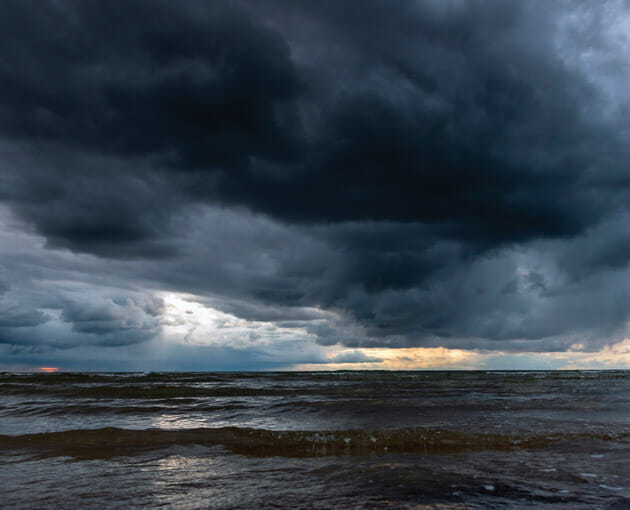My wife Eliza and I live in the Barefoot Beach community of Bonita Springs. When our power went out Wednesday morning, we decided to go to the clubhouse, just across the parking lot from our building, to charge our phones and use hot water as we could see the lights there. From our sixth-floor vantage point, we could see the waves breaching the beach, the mangrove and sea grape forests, and flowing into the garage. With no electricity, we had to take the stairs down and the water rushing into the garage made the exit door hard to open. We thought we could cross the parking lot, but once we saw the water flow, Eliza decided to go back upstairs.
 I walked through our garage to the entrance and realized the waves were too high to cross the lot safely. When I returned to the stairway door, I found it locked. Eliza had gone back up, and I had no key. The elevator was out, and I was stuck. I hoped that Eliza would realize I didn’t have my key (not uncommon for me) and come let me in, so I found a perch in the entranceway.
I walked through our garage to the entrance and realized the waves were too high to cross the lot safely. When I returned to the stairway door, I found it locked. Eliza had gone back up, and I had no key. The elevator was out, and I was stuck. I hoped that Eliza would realize I didn’t have my key (not uncommon for me) and come let me in, so I found a perch in the entranceway.
From my four-foot elevation, I watched the waves pound across the beach, the dunes, into and through the garage, and out the other side onto the road. The waves grew larger, and I used a handrail to mark the water level in the structure. Several times I left my perch to venture to the back of the building where there was less wind, hoping to do a quick scoot across to the clubhouse. Each time I found it impassable and returned to my spot. When the waves began splashing me in the face, I realized if I didn’t move, I would drown. By this point, I was sure Eliza thought I was enjoying a hot tea in the clubhouse.
With limited options, I followed the path of the water rushing by, hung on to the exit gate, and considered my alternatives. Before I had a plan, the wind lifted me and threw me like a ragdoll across Barefoot Beach Boulevard and straight into the mangrove forest. The force was incredible. As I clung to a tree, I noticed tables, chairs, paddle boards, and kayaks flying through the air. They broke in half as they hit the trees and I realized that if one of them hit me, I would not survive. I decided to let the water and the wind carry me further into the mangroves for protection. Deeper in, I found an assortment of objects, including benches, paddleboards, and even a submerged red kayak. I hoped the kayak would provide a place to stay, but it kept tipping. A large green object was nearby; it appeared to be a strangely shaped and partially submerged kayak. I swam over to the capsized kayak and realized it belonged to my neighbor, Jon Fay. It wasn’t easy to clamber onto it as it had a large draft. One of my paddles came flying by, so I grabbed it.
I assumed that if I paddled through this mangrove forest, I would come to the bay behind our building. Since the wind was blowing from south to north, I thought I might be driven toward Bonita Beach Road and perhaps help.
When I floated into the bay (it was less paddling and more pulling forward with the trees on each side), I was disheartened to discover I was not in the bay behind our building, and that debris was piled up at the end. Staying on top of the overturned kayak and using my broken paddle, I crossed the water to the next mangrove forest, hoping it might lead to the correct bay. The new forest was so dense that it caused my still upside-down kayak to snag on roots and branches, significantly limiting my forward progress. I needed to go underneath the kayak and release the seat and pedal mechanisms to unsnag myself. Remembering how hard it was to get on the kayak, and considering the alligators and snakes, I did not want to do it but knew I had to.
I slid off and went under, detached the snags, got back on, and made a little progress. I got hooked again. Once again, I got off the kayak, detached the snags, and climbed back. It was exhausting, and I was making almost no progress. I knew I needed to turn the boat over so the seat and pedal mechanism would stop snagging. I climbed into the water again. The water was over 10 feet deep, I had no purchase, and the kayak was a large one… 100 pounds! I struggled to lift it but could only get it up slightly. I found a branch not far from the boat, so I shoved the boat over and climbed on the branch. I tried to upright the boat ten or fifteen times without success. Then it occurred to me that if I moved the boat perpendicular to the wind, I could get some assistance. I waited for a strong gust and heaved; the wind grabbed the edge and flipped the boat over.
I was so close! I had a paddle and an upright kayak with no water inside, but I still had to get in. The gunnels were very high, and each time I threw a leg up and over, the boat would start to tip. I was afraid of tipping it over on top of me, but I had to keep trying. Eventually, I was successful and was able to use the paddle to get back to an open area. I planned to paddle against the wind and go around the mangrove forest rather than through it. I hadn’t gone far when a harsh gust tipped me over, and all I could think was, “No! I’ve got to do the whole exercise again!”
This time the wind was stronger, making it easier to turn the boat over, but my paddle was blown away. Once the boat was right-side-up, I clambered in and retreated into the mangroves. I was shivering and worried about hypothermia. While I waited, I kept thinking that this could not be happening—it was simply a bad dream—this wasn’t reality. At that moment, I remembered my basic training drill instructor telling me, “This is reality; deal with it.”
Until then, the sky had been grey, sending heavy winds and dumping biting rain. As the skies darkened, I knew I would not survive the night in the open. The wind was also changing. It was no longer blowing south to north but north to south. If I could get into the wind, the current and the pedal mechanism could drive me down the bay to the Delnor Wiggins Pass. There I could get onto a beach and make my way to the state park, where there might be help.
The rain was slanting hard and blinding me, forcing me to maneuver with my eyes half shut. I finally got the boat out into the bay, and the wind picked me up and took me in the direction I had hoped it would. As I was pushed forward, I noticed the outline of condominium buildings south of where I live. I remembered Building 9 had a kayak launch—if I could get there, I could get to dry land and go home. Navigation was almost impossible since the peddle mechanism only partially worked and the rudder was stuck in the wrong position. I got as close to the building as possible by maneuvering into the first line of mangroves. At that point, I abandoned ship and swam over to the building.
 Joy flooded me as I saw the building’s concrete foundation under the mangroves. I clambered out of the boat and made my way to the garage. The wind threw me over again when I came out of the building, but I managed to make my way across the parking lot to Barefoot Beach Boulevard while tripping on displaced concrete and bricks and being pushed down by wind gusts. I was able to swim/walk up the boulevard to my Building 3.
Joy flooded me as I saw the building’s concrete foundation under the mangroves. I clambered out of the boat and made my way to the garage. The wind threw me over again when I came out of the building, but I managed to make my way across the parking lot to Barefoot Beach Boulevard while tripping on displaced concrete and bricks and being pushed down by wind gusts. I was able to swim/walk up the boulevard to my Building 3.
Lights were flashing at my building, and I assumed it was first responders looking for me—I was ready for warm blankets and hot chocolate. But that was not the case; to my disappointment, the storm had triggered the fire alarm. Fortunately, the stairway door, which had locked me out and started this entire journey, had been blown away so I was able to enter the stairwell. It was completely dark, but I made it to my floor by counting each level. When I attempted to open the door to our corridor, it was locked. I could not believe it.
I walked down two flights hoping to reach our neighbors, Jon and Elissa Fay, but their corridor door was locked too. I felt my way down to the bottom floor, thinking I could now make it to the clubhouse and seek shelter there. It was at that moment that I saw a light. As I made my way toward it, I discovered it was the flashlight of my friend Jon Fay whose kayak had saved me. The waves had diminished, and we agreed to venture to the clubhouse. Since I was now an expert in tripping through buried concrete remnants, I volunteered to go first. I tried, but I kept tripping and getting blown over; the storm surge had created a large chasm, and we couldn’t cross it. We turned back. My addled brain finally registered that if he was here, he must be able to get back to his unit. I asked him how he managed with the stairwell doors locked, and he explained that they weren’t locked. The air rushing up the stairwell had created a wind tunnel effect, and if you pushed down the handle and shoved the door with your shoulder, it would open. By then, my shock was apparent. He gently, with a flashlight, guided me to my floor. We opened the door, entered the corridor, and walked to my unit. When I opened my door, Eliza looked at me in shock and astonishment. I must have looked like an apparition, but she rushed forward and lovingly embraced me. The nine hours of loss were written on her face.
She stripped me of my clothes, wrapped me in warm blankets, and tucked me into bed. I realized that my body was cut all over, bleeding, and badly bruised from all the collisions with trees and branches. I also had something scary in my left eye that hurt. I shivered uncontrollably for over an hour.
Jon’s dear wife Elissa brought me some lemon sugar water to help with the shock. I couldn’t sleep that night because of the dreams. Each time I woke, I kept rethinking the decisions I had made.
The next morning I felt better, but my muscles ached horribly. I was unable to sit up without help, and I couldn’t elevate my legs without assistance. The muscles that had served me so well were kaput. God’s help was the miracle that brought me home. The precise timing that allowed me to meet Jon was God’s doing. I cannot imagine the outcome if he had come down ten minutes earlier or ten minutes later.
by Member Hugh Nevin





